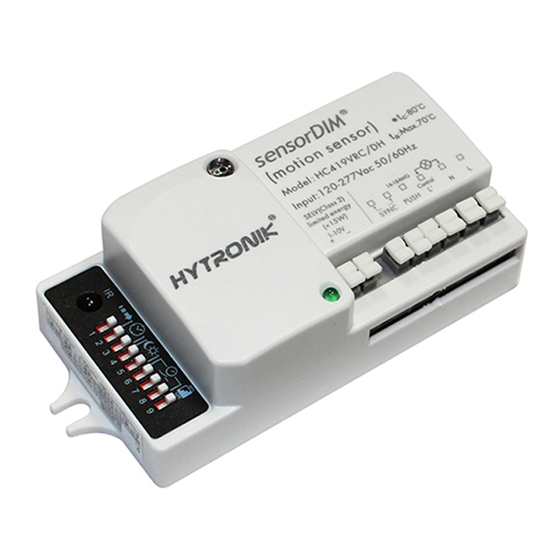Table of Contents
Advertisement
Quick Links
HC419VRC/DH
Introduction
This product utilises photocell advance
technology to realise occupancy and true
automatic photocell functions in one product.
The patented technology allows luminaire
design to be simplified as the luminaire body
no longer needs to be drilled to accept a
photocell for assessing the daylight condition.
This sensor can tell the difference of nature
light and artificial light (LED) from behind the
diffuser, and measure ambient natural light
then calculate how much artificial light is
needed to reach the target lux level. The need
is passed to the driver by 1-10V signal for
delivering the right amount of light.
The light will be dimmed to minimum level and
switched off eventually if ambient daylight is
sufficient, no matter it is during hold-time or
stand-by time, with or without motion.
Installation
Please read this manual carefully before
installing the microwave sensor and siting the
luminaire.
Both the microwave sensor (antenna) and the
photocell elements of the product must be in
front of any metal work and have full line of
sight to the cover/diffusing element of the
fixture for trouble-free operation.
After Installing the sensor, it is highly
recommended that the luminaire is tested for
compatibility and correct operation of all
components.
Note: If testing under laboratory conditions,
the unique nature of this product requires full
bandwidth of the visible and invisible parts of
the electromagnetic spectrum, therefore it is
not recommended to attempt daylight
simulation with artificail light sources.
Not suitable for use with
Incandescent or Halogen
lamps
Not suitable for use in
installations where glass
is treated for reflection
of infrared radiation
Installation and Instruction Manual
Fixture Built-in Microwave Sensor
Technical Specifications
Product type
Built-in microwave motion sensor (daylight harvest)
Operating voltage
120~277VAC 50/60Hz
Switched power
Capacitive: 400VA/120VAC; 1000VA/277VAC
Resistive: 700W/120VAC; 1600W/277VAC
Stand-by power
< 0.8W
Detection settings
10% / 50% / 75% / 100%
Hold time
2s / 5s / 30s / 1min / 3min / 5min /
10min / 15min / 20min / 30min
Stand-by time
0s / 10s / 1min / 5min / 10min / 30min / 1h / +
Stand-by dimming level
10% / 20% / 30% / 50%
Daylight threshold
2 ~ 500Lux , Disable
Detection area (DxH)
12 x 6 m
Microwave frequency
5.8 GHz +/- 75Mhz
Microwave power
<0.2 mW
Warmming-up time
20s
o
Operating temperature
-20
C ~ +60
Diagram 1. Typical layout - in front of LED PCB
Base
LED PCB
Diffuser (Non-metal)
Glass less than 0.5cm
Diagram 2. Typical layout - behind LED PCB with cut-out
LED PCB
22mm PCB support pillars
o
C
Sensing direction
Cut-out 45mm x 31mm
Sensing direction
Daylight Harvest
Buzzer
Sensor antenna
Infrared remote receiver
Daylight sensor 2
Detection area
Hold-time
Daylight sensor
Stand-by period
Stand-by dimming level
1-10V +
Daylight sensor 1
1-10V-
SYNC
Dimensions (mm)
Preparation of Luminaire
1. Positioning
This microwave sensor is ideal for use with LED
luminaires with the following considerations:
For simple mounting, the sensor may be placed on
the LED side of the LED PCB. The microwave
sensor will not be able to 'see' through any metal
components of the fixture. (See diagram 1
opposite).
For shadow-free operation, it is recommended that
the LED PCB is designed with a viewing window for
the sensor so that it may fit flush (or slightly proud)
of the LED PCB. (Please refer to diagram 2)
2. Configure the luminaire
Referring to the wiring diagrams overleaf, it is best
to consider terminations of the luminaires offered to
the installer dependant on system or project design.
If in any doubt, it is recommended that all 8
terminals of the sensor are made accessible to the
installer so that all of the features may be used if
required.
3. Wiring
To assist with installation, Hytronik use push-wire
style terminals. It is recommended that single core
(1/0.8mm for example) is used for making the
connections to the sensor.
The full specification for the wiring terminal is:
Wire preparation
0.75-1.5
8mm
HC419VRC/DH-20170428-A1
Installation hole (4.2mm)
L' N L
Push
Advertisement
Table of Contents

Summary of Contents for Hytronik HC419VRC/DH
- Page 1 Incandescent or Halogen lamps 3. Wiring Sensing direction To assist with installation, Hytronik use push-wire style terminals. It is recommended that single core (1/0.8mm for example) is used for making the connections to the sensor. Not suitable for use in The full specification for the wiring terminal is:...
- Page 2 By connecting the “SYNC” terminals in parallel (maximum 10pcs, see wiring diagram next Zero-cross relay operation page), no matter which sensor detects motion, all HC419VRC/DH connected will turn on the lights when surrounding natural light is below the daylight threshold which can be set by Designed in the software, sensor switches on/off the load right at the zero-cross point, to either DIP switch on the sensor unit or remote control HRC-11.
- Page 3 Note: 1.To set hold-time at 30s / 5min / 15min / 30min, press button Shift at first. *If required - (no earth connection neccessary on HC419VRC/DH) 2. 2s is for test purpose only, stand-by period and daylight sensor settings are disabled in this mode.
















Need help?
Do you have a question about the HC419VRC/DH and is the answer not in the manual?
Questions and answers